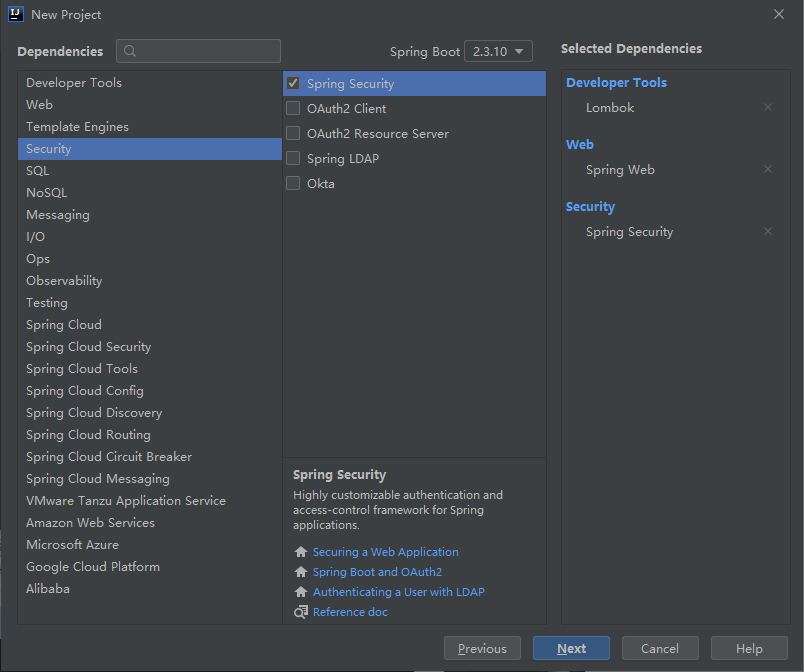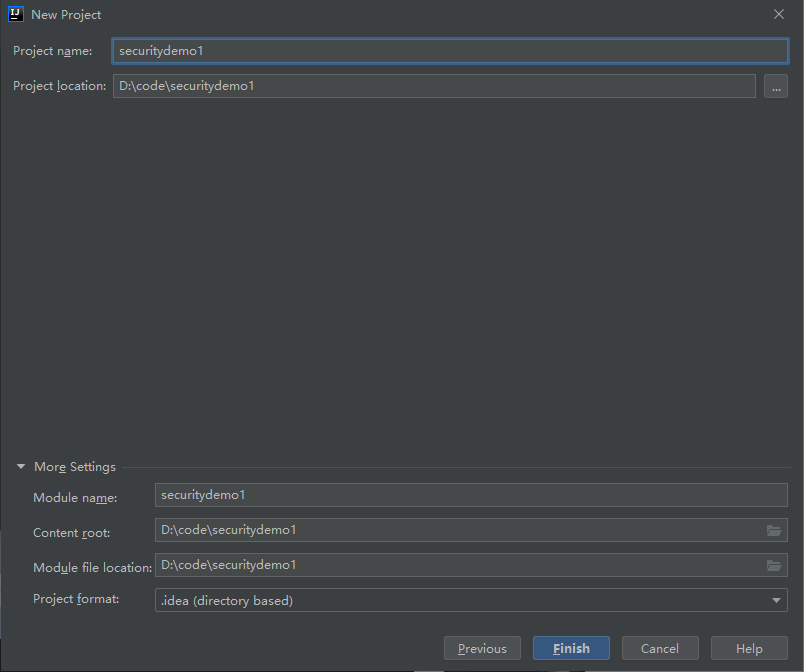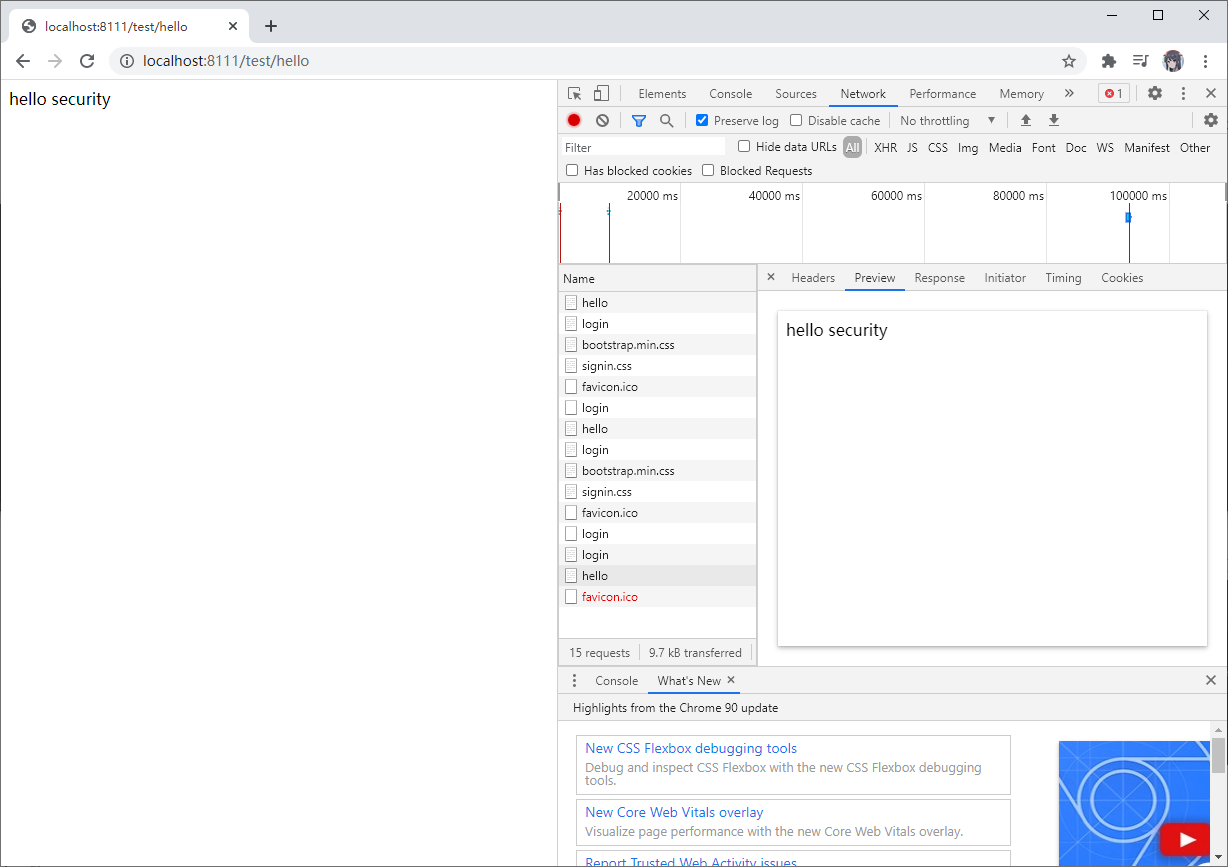Spring Security 入门案例
2.1 创建一个项目



编写一个Controller
package com.atgugui.securitydemo1.controller;
import org.springframework.web.bind.annotation.GetMapping;
import org.springframework.web.bind.annotation.RequestMapping;
import org.springframework.web.bind.annotation.RestController;
@RestController
@RequestMapping("/test")
public class TestController {
@GetMapping("hello")
public String hello() {
return "hello security";
}
}
设置启动端口
server.port=8111
2.2 运行这个项目
http://localhost:8111/test/hello

默认的用户名:user
密码在项目启动的时候在控制台会打印,注意每次启动的时候密码都回发生变化!

输入用户名,密码,这样表示可以访问了,404 表示我们没有这个控制器,但是我们可以访问了。

2.3 权限管理中的相关概念
2.3.1 主体
英文单词:principal
使用系统的用户或设备或从其他系统远程登录的用户等等。简单说就是谁使用系统谁就是主体。
2.3.2 认证
英文单词:authentication
权限管理系统确认一个主体的身份,允许主体进入系统。简单说就是“主体”证明自己是谁
笼统的认为就是以前所做的登录操作。
2.3.3 授权
英文单词:authorization
将操作系统的“权力”“授予”“主体”,这样主体就具备了操作系统中特定功能的能力。 所以简单来说,授权就是给用户分配权限。
2.5 SpringSecurity 基本原理
SpringSecurity 本质是一个过滤器链
从启动时可以获取到过滤器链:
org.springframework.security.web.context.request.async.WebAsyncManagerIntegrationFilter
org.springframework.security.web.context.SecurityContextPersistenceFilter
org.springframework.security.web.header.HeaderWriterFilter
org.springframework.security.web.csrf.CsrfFilter
org.springframework.security.web.authentication.logout.LogoutFilter
org.springframework.security.web.authentication.UsernamePasswordAuthenticationFilter
org.springframework.security.web.authentication.ui.DefaultLoginPageGeneratingFilter
org.springframework.security.web.authentication.ui.DefaultLogoutPageGeneratingFilter
org.springframework.security.web.savedrequest.RequestCacheAwareFilter
org.springframework.security.web.servletapi.SecurityContextHolderAwareRequestFilter
org.springframework.security.web.authentication.AnonymousAuthenticationFilter
org.springframework.security.web.session.SessionManagementFilter
org.springframework.security.web.access.ExceptionTranslationFilter
org.springframework.security.web.access.intercept.FilterSecurityInterceptor
代码底层流程:
重点看三个过滤器:
FilterSecurityInterceptor:是一个方法级的权限过滤器,基本位于过滤链的最底部。(什么方法能访问,什么方法不能访问)
/**
* Method that is actually called by the filter chain. Simply delegates to the
* {@link #invoke(FilterInvocation)} method.
*
* @param request the servlet request
* @param response the servlet response
* @param chain the filter chain
*
* @throws IOException if the filter chain fails
* @throws ServletException if the filter chain fails
*/
public void doFilter(ServletRequest request, ServletResponse response,
FilterChain chain) throws IOException, ServletException {
FilterInvocation fi = new FilterInvocation(request, response, chain);
invoke(fi);
}
public void invoke(FilterInvocation fi) throws IOException, ServletException {
if ((fi.getRequest() != null)
&& (fi.getRequest().getAttribute(FILTER_APPLIED) != null)
&& observeOncePerRequest) {
// filter already applied to this request and user wants us to observe
// once-per-request handling, so don't re-do security checking
fi.getChain().doFilter(fi.getRequest(), fi.getResponse());
}
else {
// first time this request being called, so perform security checking
if (fi.getRequest() != null && observeOncePerRequest) {
fi.getRequest().setAttribute(FILTER_APPLIED, Boolean.TRUE);
}
// 之前
InterceptorStatusToken token = super.beforeInvocation(fi);
try {
// 本身的invoke方法
fi.getChain().doFilter(fi.getRequest(), fi.getResponse());
}
finally {
super.finallyInvocation(token);
}
super.afterInvocation(token, null);
}
}
super.beforeInvocation(fi) 表示查看之前的 filter 是否通过。
fi.getChain().doFilter(fi.getRequest(), fi.getResponse());表示真正的调用后台的服务。
ExceptionTranslationFilter:是个异常过滤器,用来处理在认证授权过程中抛出的异常
public void doFilter(ServletRequest req, ServletResponse res, FilterChain chain)
throws IOException, ServletException {
HttpServletRequest request = (HttpServletRequest) req;
HttpServletResponse response = (HttpServletResponse) res;
try {
chain.doFilter(request, response);
logger.debug("Chain processed normally");
}
catch (IOException ex) {
throw ex;
}
catch (Exception ex) {
// Try to extract a SpringSecurityException from the stacktrace
Throwable[] causeChain = throwableAnalyzer.determineCauseChain(ex);
RuntimeException ase = (AuthenticationException) throwableAnalyzer
.getFirstThrowableOfType(AuthenticationException.class, causeChain);
if (ase == null) {
ase = (AccessDeniedException) throwableAnalyzer.getFirstThrowableOfType(
AccessDeniedException.class, causeChain);
}
if (ase != null) {
if (response.isCommitted()) {
throw new ServletException("Unable to handle the Spring Security Exception because the response is already committed.", ex);
}
handleSpringSecurityException(request, response, chain, ase);
}
else {
// Rethrow ServletExceptions and RuntimeExceptions as-is
if (ex instanceof ServletException) {
throw (ServletException) ex;
}
else if (ex instanceof RuntimeException) {
throw (RuntimeException) ex;
}
// Wrap other Exceptions. This shouldn't actually happen
// as we've already covered all the possibilities for doFilter
throw new RuntimeException(ex);
}
}
}
UsernamePasswordAuthenticationFilter :对/login 的 POST 请求做拦截,校验表单中用户名,密码。
// ~ Methods
// ========================================================================================================
public Authentication attemptAuthentication(HttpServletRequest request,
HttpServletResponse response) throws AuthenticationException {
if (postOnly && !request.getMethod().equals("POST")) {
throw new AuthenticationServiceException(
"Authentication method not supported: " + request.getMethod());
}
String username = obtainUsername(request);
String password = obtainPassword(request);
if (username == null) {
username = "";
}
if (password == null) {
password = "";
}
username = username.trim();
UsernamePasswordAuthenticationToken authRequest = new UsernamePasswordAuthenticationToken(
username, password);
// Allow subclasses to set the "details" property
setDetails(request, authRequest);
return this.getAuthenticationManager().authenticate(authRequest);
}
2.6 UserDetailsService 接口讲解
创建类维承UsernamePasswordAuthenticationFilter,重写三个方法
创建类实现UserDetailService,编写查询数据过程,返回User对象,这个User对象是安全框架提供对象
当什么也没有配置的时候,账号和密码是由 Spring Security 定义生成的。而在实际项目中 账号和密码都是从数据库中查询出来的。 所以我们要通过自定义逻辑控制认证逻辑。
如果需要自定义逻辑时,只需要实现 UserDetailsService 接口即可。
接口定义如下:
package org.springframework.security.core.userdetails;
/**
* Core interface which loads user-specific data.
* <p>
* It is used throughout the framework as a user DAO and is the strategy used by the
* {@link org.springframework.security.authentication.dao.DaoAuthenticationProvider
* DaoAuthenticationProvider}.
*
* <p>
* The interface requires only one read-only method, which simplifies support for new
* data-access strategies.
*
* @see org.springframework.security.authentication.dao.DaoAuthenticationProvider
* @see UserDetails
*
* @author Ben Alex
*/
public interface UserDetailsService {
// ~ Methods
// ========================================================================================================
/**
* Locates the user based on the username. In the actual implementation, the search
* may possibly be case sensitive, or case insensitive depending on how the
* implementation instance is configured. In this case, the <code>UserDetails</code>
* object that comes back may have a username that is of a different case than what
* was actually requested..
*
* @param username the username identifying the user whose data is required.
*
* @return a fully populated user record (never <code>null</code>)
*
* @throws UsernameNotFoundException if the user could not be found or the user has no
* GrantedAuthority
*/
UserDetails loadUserByUsername(String username) throws UsernameNotFoundException;
}
返回值 UserDetails
这个类是系统默认的用户“主体”
package org.springframework.security.core.userdetails;
import org.springframework.security.core.Authentication;
import org.springframework.security.core.GrantedAuthority;
import java.io.Serializable;
import java.util.Collection;
/**
* Provides core user information.
*
* <p>
* Implementations are not used directly by Spring Security for security purposes. They
* simply store user information which is later encapsulated into {@link Authentication}
* objects. This allows non-security related user information (such as email addresses,
* telephone numbers etc) to be stored in a convenient location.
* <p>
* Concrete implementations must take particular care to ensure the non-null contract
* detailed for each method is enforced. See
* {@link org.springframework.security.core.userdetails.User} for a reference
* implementation (which you might like to extend or use in your code).
*
* @see UserDetailsService
* @see UserCache
*
* @author Ben Alex
*/
public interface UserDetails extends Serializable {
// ~ Methods
// ========================================================================================================
/**
* Returns the authorities granted to the user. Cannot return <code>null</code>.
*
* @return the authorities, sorted by natural key (never <code>null</code>)
*/
Collection<? extends GrantedAuthority> getAuthorities();
/**
* Returns the password used to authenticate the user.
*
* @return the password
*/
String getPassword();
/**
* Returns the username used to authenticate the user. Cannot return <code>null</code>.
*
* @return the username (never <code>null</code>)
*/
String getUsername();
/**
* Indicates whether the user's account has expired. An expired account cannot be
* authenticated.
*
* @return <code>true</code> if the user's account is valid (ie non-expired),
* <code>false</code> if no longer valid (ie expired)
*/
boolean isAccountNonExpired();
/**
* Indicates whether the user is locked or unlocked. A locked user cannot be
* authenticated.
*
* @return <code>true</code> if the user is not locked, <code>false</code> otherwise
*/
boolean isAccountNonLocked();
/**
* Indicates whether the user's credentials (password) has expired. Expired
* credentials prevent authentication.
*
* @return <code>true</code> if the user's credentials are valid (ie non-expired),
* <code>false</code> if no longer valid (ie expired)
*/
boolean isCredentialsNonExpired();
/**
* Indicates whether the user is enabled or disabled. A disabled user cannot be
* authenticated.
*
* @return <code>true</code> if the user is enabled, <code>false</code> otherwise
*/
boolean isEnabled();
}
方法参数 username
表示用户名。此值是客户端表单传递过来的数据。默认情况下必须叫 username,否则无 法接收。
2.7 PasswordEncoder 接口讲解
package org.springframework.security.crypto.password;
/**
* Service interface for encoding passwords.
*
* The preferred implementation is {@code BCryptPasswordEncoder}.
*
* @author Keith Donald
*/
public interface PasswordEncoder {
/**
* Encode the raw password. Generally, a good encoding algorithm applies a SHA-1 or
* greater hash combined with an 8-byte or greater randomly generated salt.
*/
String encode(CharSequence rawPassword);
/**
* Verify the encoded password obtained from storage matches the submitted raw
* password after it too is encoded. Returns true if the passwords match, false if
* they do not. The stored password itself is never decoded.
*
* @param rawPassword the raw password to encode and match
* @param encodedPassword the encoded password from storage to compare with
* @return true if the raw password, after encoding, matches the encoded password from
* storage
*/
boolean matches(CharSequence rawPassword, String encodedPassword);
/**
* Returns true if the encoded password should be encoded again for better security,
* else false. The default implementation always returns false.
* @param encodedPassword the encoded password to check
* @return true if the encoded password should be encoded again for better security,
* else false.
*/
default boolean upgradeEncoding(String encodedPassword) {
return false;
}
}
encode:表示把参数按照特定的解析规则进行解析
matches:表示验证从存储中获取的编码密码与编码后提交的原始密码是否匹配。如果密码匹 配,则返回 true;如果不匹配,则返回 false。第一个参数表示需要被解析的密码。第二个 参数表示存储的密码。
upgradeEncoding: 表示如果解析的密码能够再次进行解析且达到更安全的结果则返回 true,否则返回 false。默认返回 false。
接口实现类
/**
* Implementation of PasswordEncoder that uses the BCrypt strong hashing function. Clients
* can optionally supply a "version" ($2a, $2b, $2y) and a "strength" (a.k.a. log rounds in BCrypt)
* and a SecureRandom instance. The larger the strength parameter the more work will have to be done
* (exponentially) to hash the passwords. The default value is 10.
*
* @author Dave Syer
*/
public class BCryptPasswordEncoder implements PasswordEncoder {
BCryptPasswordEncoder 是 Spring Security 官方推荐的密码解析器,平时多使用这个解析器。
BCryptPasswordEncoder 是对 bcrypt 强散列方法的具体实现。是基于 Hash 算法实现的单 向加密。可以通过 strength 控制加密强度,默认 10。
查用方法演示
@Test
public void test01() {
// 创建密码解析器
BCryptPasswordEncoder bCryptPasswordEncoder = new BCryptPasswordEncoder();
// 对密码进行加密
String atguigu = bCryptPasswordEncoder.encode("atguigu");
// 打印加密之后的数据
System.out.println("加密之后数据:\t" + atguigu);
// 判断原字符加密后和加密之前是否匹配
boolean result = bCryptPasswordEncoder.matches("atguigu", atguigu);
// 打印比较结果
System.out.println("比较结果:\t" + result);
}

2.8 SpringBoot 对 Security 的自动配置
https://docs.spring.io/springsecurity/site/docs/5.3.4.RELEASE/reference/html5/#servlet-hello


